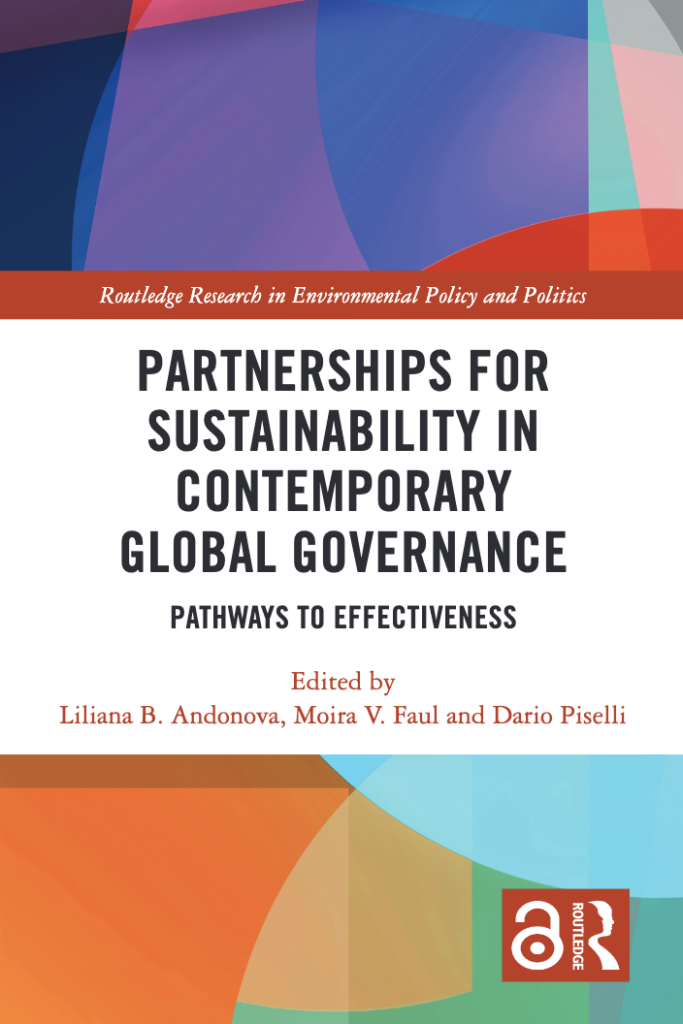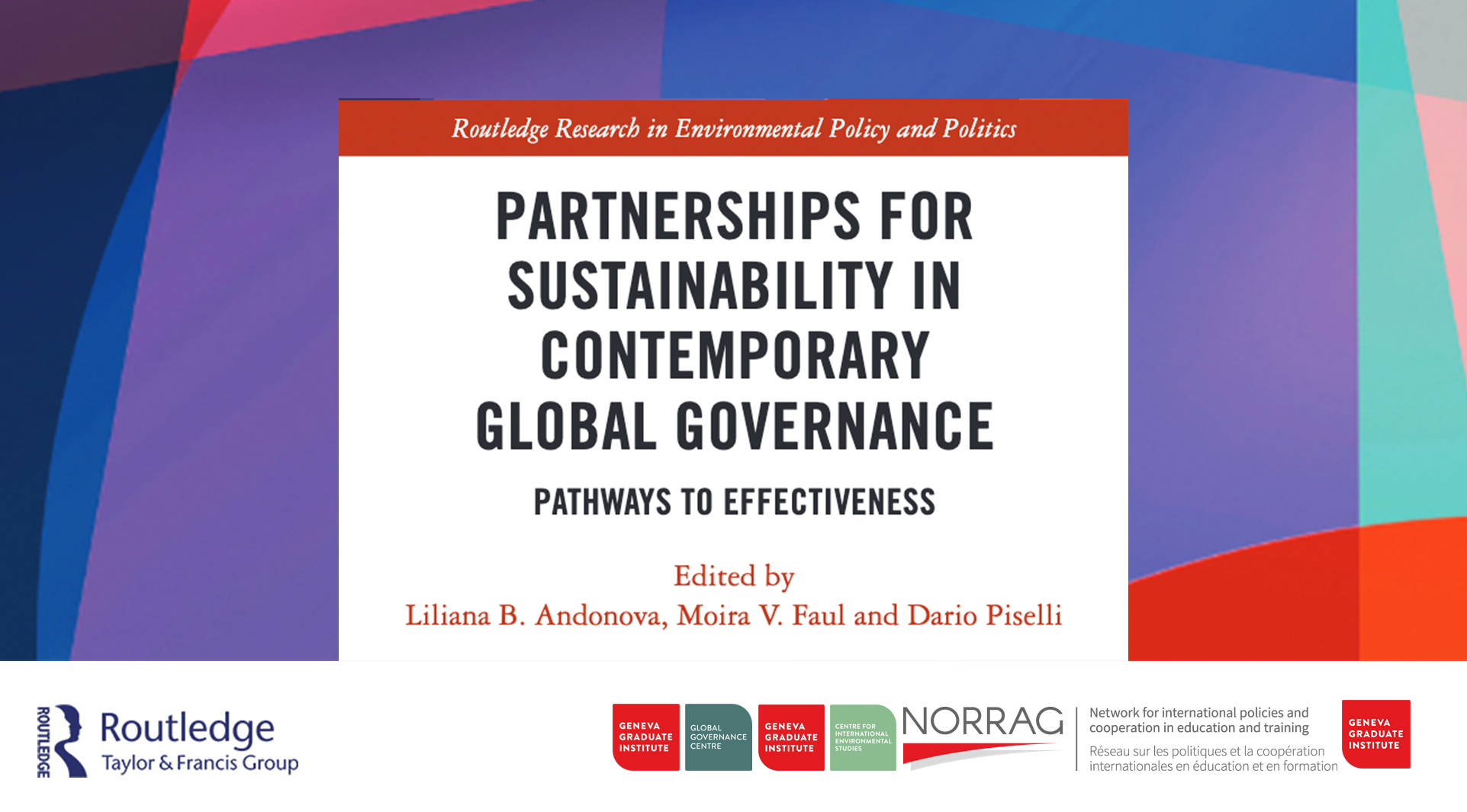Event Highlights: Book Launch: Partnerships for Sustainability in Contemporary Global Governance
On 5 September 2022, NORRAG co-hosted a hybrid event at the Geneva Graduate Institute with the Graduate Institute’s Global Governance Centre (GGC) and the Centre for International Environmental Studies (CIES) for the launch of the new book Partnerships for Sustainability in Contemporary Global Governance: Pathways to Effectiveness which investigates the goals, ideals, and realities of sustainability partnerships and offers a theoretical framework to help disentangle the multiple and interrelated pathways that shape their effectiveness.
Annabelle Littoz-Monnet, Professor, International Relations and Political Science, Director of the Global Governance Centre at the Geneva Graduate Institute chaired the event, welcoming participants in person and online. She presented the co-editors: Liliana Andonova, Moira V. Faul and Dario Piselli who introduced the book, and then moderated the panel discussion and lively Q&A with the in-person and online audience.
Moira V. Faul, NORRAG Executive Director, acknowledged the financial support of SNIS and the administrative support of the Centre for International Environmental Studies (CIES) throughout the research project that gave rise to this edited volume. She presented the partnership paradox at the heart of this book: partnerships promise a great deal, but there is scant evidence to date that they actually deliver on this promise. This book contributes a disaggregated framework of pathways to effectiveness as well as a series of rigorous empirical studies that illustrate the significance of these pathways and the complex ways in which they are interrelated.
Liliana Andonova, Professor, International Relations and Political Sciences and Co-Director of the Centre for International Environmental Studies (CIES), Geneva Graduate Institute presented the theoretical framework for partnership effectiveness put forth in the book. This innovative framework consists of five dimensions, or pathways, through which global partnerships can be assessed for their contribution to problem-solving for sustainability:
- Goal attainment, or a partnership’s stated goals and their achievements as measured against these goals
- Value creation for partners, or the value a partnership creates for partners involved in them
- Collaboration inside the partnership, or how multiple actors work together in partnership
- Impact on affected populations, both those directly and less directly involved
- Influence on collaboration and institutions outside the partnership and the ways partnerships interact with other mechanisms and systems of governance.
Dario Piselli, Expert in Environment, Health and Well-being, European Environment Agency (EEA), spoke to the empirical approach of the book. Contributing authors analysed partnerships across multiple issue areas, including climate change/biodiversity, global health, and children’s rights, which resulted in four hypotheses for conditions for partnership effectiveness. Piselli mentioned the four hypotheses, which include sophisticated contracting, commitment of resources, adaptability, and innovation (of institutions and solutions). Read about each hypothesis in-depth here.
During the panel discussion, Gilles Carbonnier, Vice President of the International Committee of the Red Cross and Professor, International Economics, the Geneva Graduate Institute, emphasised how the theoretical framework put forth in the book will transform the way in which partnerships are conceptualised. He also highlighted the practical use of the framework for those involved in partnerships, to ensure that certain pathways were not ignored.
Tina C. Ambos, Professor, Geneva School of Economics and Management (GSEM) and Director, Center for Innovation and Partnerships, University of Geneva (UNIGE), highlighted key takeaways after reading the book. Importantly, she noted, the book addresses conditions for effectiveness of partnerships from a multidisciplinary, multi-level perspective and considers the broader impact of partnerships on society. Ambos also reflected on the book from a managerial perspective and recognized the adaptable nature of the partnership effectiveness framework to analyse partnerships for their ability to create value in a sustainable manner.
Karin Backstrand, Professor, Stockholm University, spoke to the importance of partnerships for achieving Agenda 2030, and the timeliness of the new book, as well as its quality and coherence across theoretical and empirical chapters. There is a lot of hope for partnerships, evidenced by the increased funding they have received in recent years, Backstrand noted. Backstrand also posed questions in her reflection on the book about the challenge of siloization within the partnership landscape and one about how the world’s most pertinent issues (i.e. war, climate change) might affect the effectiveness of partnerships.
Paul Ladd, Director, United Nations Research Institute for Social Development (UNRISD), drew the audience’s attention to the UNRISD Flagship Report, and highlighted that partnerships alone are not enough to solve the world’s most critical issues, challenging the audience to ensure they also look at the extent to which individual sectors (especially states) are fulfilling their specific duties and obligations.
Oran Young, Professor Emeritus, University of California Santa Barbara, described the edited volume as “state of the art” and commented on the need to assess partnerships first and foremost as to whether they fit the issue they intend to address, particularly since the issue areas addressed will be crucial as the world enters the second half of Agenda 2030.
About the book
 This interdisciplinary book will be of great interest to researchers, students, and practitioners within international relations, political science, sociology, environmental studies and global studies, as well as the growing number of scholars in public policy, global health and organizational and business studies who are keen to gain a deeper understanding of the pathways and mechanisms that influence the outcomes and effectiveness of cross-sector collaboration and transnational governance more broadly.
This interdisciplinary book will be of great interest to researchers, students, and practitioners within international relations, political science, sociology, environmental studies and global studies, as well as the growing number of scholars in public policy, global health and organizational and business studies who are keen to gain a deeper understanding of the pathways and mechanisms that influence the outcomes and effectiveness of cross-sector collaboration and transnational governance more broadly.
Table of contents
Introduction
By Liliana B. Andonova, Moira V. Faul and Dario Piselli
Part I. What Are Partnerships and How to Know their Effects?
1. The Effectiveness of Partnerships: Theoretical Framework
By Liliana B. Andonova and Moira V. Faul
Part II. Thematic Case Studies
2. Governing Biodiversity and Clean Energy with Global Partners
By Liliana B. Andonova and Dario Piselli
3. Protecting the Amazon and its People: The Role of Civil Society in the Local Effectiveness of Transnational Partnerships
By Livio Silva-Muller and Moira V. Faul
4. Brokering Private Action for Sustainable Development: The Role of the World Bank
By Axel Michaelowa, Katharina Michaelowa and Liliana B. Andonova
5. Advancing Innovation and Access to Medicines: The Achievements and Unrealized Potential of the Product Development Partnership Model
By Marcela Fogaça Vieira, Ryan Kimmitt, Danielle Navarro, Anna Bezruki and Suerie Moon
6. Sustaining Partnerships: The Global Polio Eradication Initiative Case
By Mara Pillinger
7. Founding the Global Partnership to End Violence Against Children: Opportunities and Challenges on the Road to Effectiveness
By Susan L. Bissell and David Steven
Part III. Crosscutting Themes
8. Partnerships under Pressure: Lessons on Adaptation and Overcoming Challenges
By Amanda Sardonis and Henry Lee
9. Effectiveness of Transnational Partnership Regimes in Long-Term Resource Revenue Management
By Jamie Fraser and Gilles Carbonnier
10. Faultlines within Sectors in Partnership Executive Boards
By Moira V. Faul and Younes Boulaguiem
Part IV. Conclusion
11. Conclusion
By Liliana B. Andonova, Moira V. Faul and Dario Piselli

This book is the result of a research project funded by SNIS.


